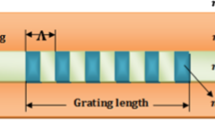Abstract
The focus of this paper is to achieve greater efficiency of fiber Bragg grating (FBG) based all-optical quasi-distributed sensing network by suitably tailoring and controlling the key optical characteristics of the FBG. Apodization profile plays a critical role in order to achieve optimum optical characteristics for the FBG. FBG with a novel apodization profile and optimized optical characteristics with respect to the key grating parameters is reported for this purpose. Performance characteristics that are critically important for optical communication as well as sensor applications are rigorously and comparatively analyzed for the FBG employing proposed apodization profile and other selected elite apodization profiles. Simulation results show that among all the apodization profiles included in the theoretical analysis, best side-lobe suppression characteristics along with a FWHM of 0.14 nm (< 0.2 nm) and reflectivity of 0.607 (> 0.5) are observed for the proposed apodization profile at optimum grating parameters (L = 10 mm and δn = 0.9 × 10–4). The proposed FBG with optimized characteristics is then employed in a five-stage quasi-distributed temperature and strain sensing network to analyze its application efficiency. An isolation of 11.15 dB and the total isolation of 33.508 dB, highest among the other apodization profiles studied in this research, are observed for the proposed grating. Further, a large dynamic range for the temperature/strain measurement up to 131.6 °C/1450µε is achieved.














Similar content being viewed by others
References
Ali, T.A., Shehata, M.I., Mohamed, N.A.: Design and performance investigation of a highly accurate apodized fiber Bragg grating-based strain sensor in single and quasi-distributed systems. Appl. Opt. 54, 5243–5251 (2015)
Canning, J., Psaila, D.C., Brodzeli, Z., Higley, A., Janos, M.: Characterization of apodized fiber Bragg gratings for rejection filter applications. Appl. Opt. 36, 9378–9382 (1997)
Carvalho, J.P., Romero, R., Melo, M., Gomes, L.A., Frazão, O., Marques, M.B., Salgado, H.M.: Optical fiber communications: recent contributions in photonic device technology. Fiber Integr. Opt. 24, 371–394 (2005)
Chan, T.H.T., Yu, L., Tam, H.Y., Liu, S.Y., Chung, W.H., Cheng, L.K.: Fiber Bragg grating sensors for structural health monitoring of Tsing Ma bridge: background and experimental observation. Eng. Struct. 28, 648–659 (2006)
Ennser, K., Zervas, M.N., Lamming, R.I.: Optimization of apodized linearly chirped fiber gratings for optical communications. IEEE J. Quant. Electron. 34, 770–778 (1998)
Erdogan, T.: Fiber grating spectra. IEEE J. Lightwave Technol. 15, 1277–1294 (1997)
Kashyap, R.: Fiber Bragg gratings, 2nd edn. Academic Press, New York (2010)
Kolpakov, S.A., Barmenkov, Y.O., Aboites, V.: Asymmetrically apodized fiber Bragg gratings for applications in dispersion less fabry-prot fiber cavities. Fiber Integr. Opt. 29, 466–479 (2010)
Mohammed, N., Serafy, H.: Ultra-sensitive quasi-distributed temperature sensor based on an apodized fiber Bragg grating. Appl. Opt. 57, 273–282 (2018)
Mohammed, N., Ali, T., Aly, M.: Performance optimization of apodized FBG-based temperature sensors in single and quasi-distributed DWDM systems with new and different apodization profiles. AIP Adv. 3, 122125-1-122125–21 (2013)
Mohammed, N.A., Ali, T.A., Aly, M.H.: Evaluation and performance enhancement for accurate FBG temperature sensor measurement with different apodization profiles in single and quasi-distributed DWDM systems. Opt. Laser Eng. 55, 22–34 (2014)
Othonos, A., Kalli, K.: Fiber Bragg gratings. Artech House, London (1999)
Rebola, J.L., Cartaxo, A.V.T.: Performance optimization of Gaussian apodized fiber Bragg grating filter in WDM system. IEEE J. Lightwave Technol. 20, 1537–1544 (2002)
Funding
The present work is partially supported by a research grant under GATE fellowship (India). One of the authors (Krishna Mohan Dwivedi) is grateful for this support.
Author information
Authors and Affiliations
Corresponding author
Ethics declarations
Conflict of interest
The authors have not disclosed any competing interests.
Additional information
Publisher's Note
Springer Nature remains neutral with regard to jurisdictional claims in published maps and institutional affiliations.
Rights and permissions
About this article
Cite this article
Dwivedi, K.M., Trivedi, G. & Khijwania, S.K. Fiber Bragg grating employing novel apodization profile: performance optimization for quasi-distributed sensing applications. Opt Quant Electron 54, 338 (2022). https://doi.org/10.1007/s11082-022-03691-y
Received:
Accepted:
Published:
DOI: https://doi.org/10.1007/s11082-022-03691-y



